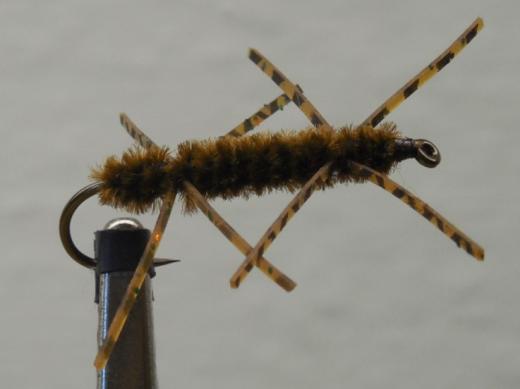Fly of the Month - Pat's Rubber Legs
Materials:
Hook: Tiemco 5263, #6, 8, and 10
Thread: Black or brown 8/0
Underbody (weight): Small nontoxic wire
Body: Black or dark brown chenille
Legs: Various dark flat rubber legs
Salmonflies! The mere utterance drives us into a frenzy of anticipation. Scads of eager anglers descend yearly on every river populated by those Paleolithic insects, hoping to time the adult emergence just right. While that sometimes happens, to great enjoyment, the preceding form of Petronarcys Californica often provides more predictable and reliable fishing, and for many more months. Since the nymphs have a several year life cycle before progressing to the next stage, they are always present and often active. One of the simplest and most effective imitations is Pat’s Rubber Legs. I’d venture a prediction that it would be hard to find a fly shop or guide in Montana that doesn’t list that fly as the number one choice for subsurface action. I confess that I haven’t tried it here in Oregon since I don’t get to the Deschutes as often as in earlier years, but from my trips to the Madison, I’d suspect that it is equally effective here. Our stalwart newsletter editor made the supreme sacrifice to travel there this summer to test it out, and reports are that it lived up to its reputation. I don’t know Pat, but we owe him or her many thanks.
Wind and wrap a wire underbody (each wrap tight against the previous wrap) from about 1/8 inch from the start of the hook bend to about 1/4 inch from the back of the eye. Trim the tag ends.
Attach the thread just behind the eye, and with a series of spiral wraps over the wire, wind back and forth three or four times from just in front of the wire to just back of the wire. This secures the wire in place and provides a “skin” over the wire so that the other materials will adhere and not force themselves down between the wire wraps. To provide an even transition to the diameter of the wire wraps, add thread windings on the hook shank next to the ends of the wire wraps, to create tapered thread wraps up to the wire. End with the thread bobbin just in back of the back end of the wire.
Cut a six inch piece of chenille and tie in the tip at the start of the bend of the hook. Then wind the thread to about ¼ of the way to the eye. I use medium for smaller flies and large for bigger flies.
Cut leg segments of about 2/1/2 to 3 inches long (they will be trimmed to length when the fly is finished). Holding a piece horizontal to the hook shank with the middle of the segment at the thread point, tie in a back leg with three thread wraps. The legs will bend outward and roughly horizontal as you wrap them in. Round rubber legs also can be used, but they tend to roll out of horizontal as you wrap them; flat leg material is more forgiving. Repeat on the other side.
Wrap the thread to about ¾ of the way to the eye, and tie in front legs on each side. Wrap thread to the back of the eye and leave hanging.
Wind the chenille in moderately tight turns to the back legs, then one turn between the legs on each side, then to the front legs (same treatment) and finally to just behind the eye. If needed, you can hold the tag ends of the legs on each side as you make the wraps before, in between and in front, and gently move and hold them back in roughly a horizontal position. Tie off and clip.
Wrap a fairly large head, clip and cement.
Clip the legs to length – about one inch, but slightly shorter for smaller flies up to slightly longer for larger flies.


